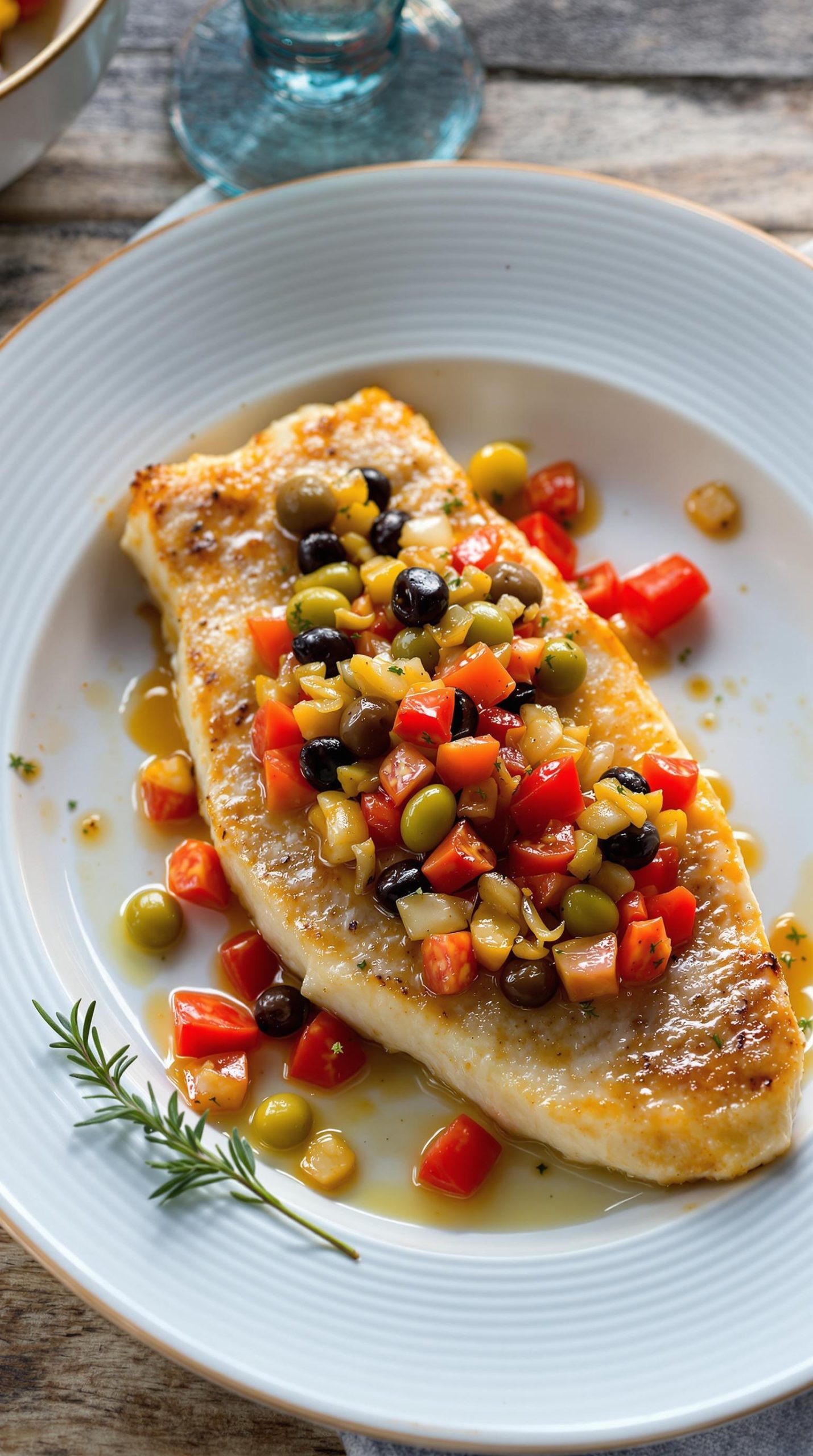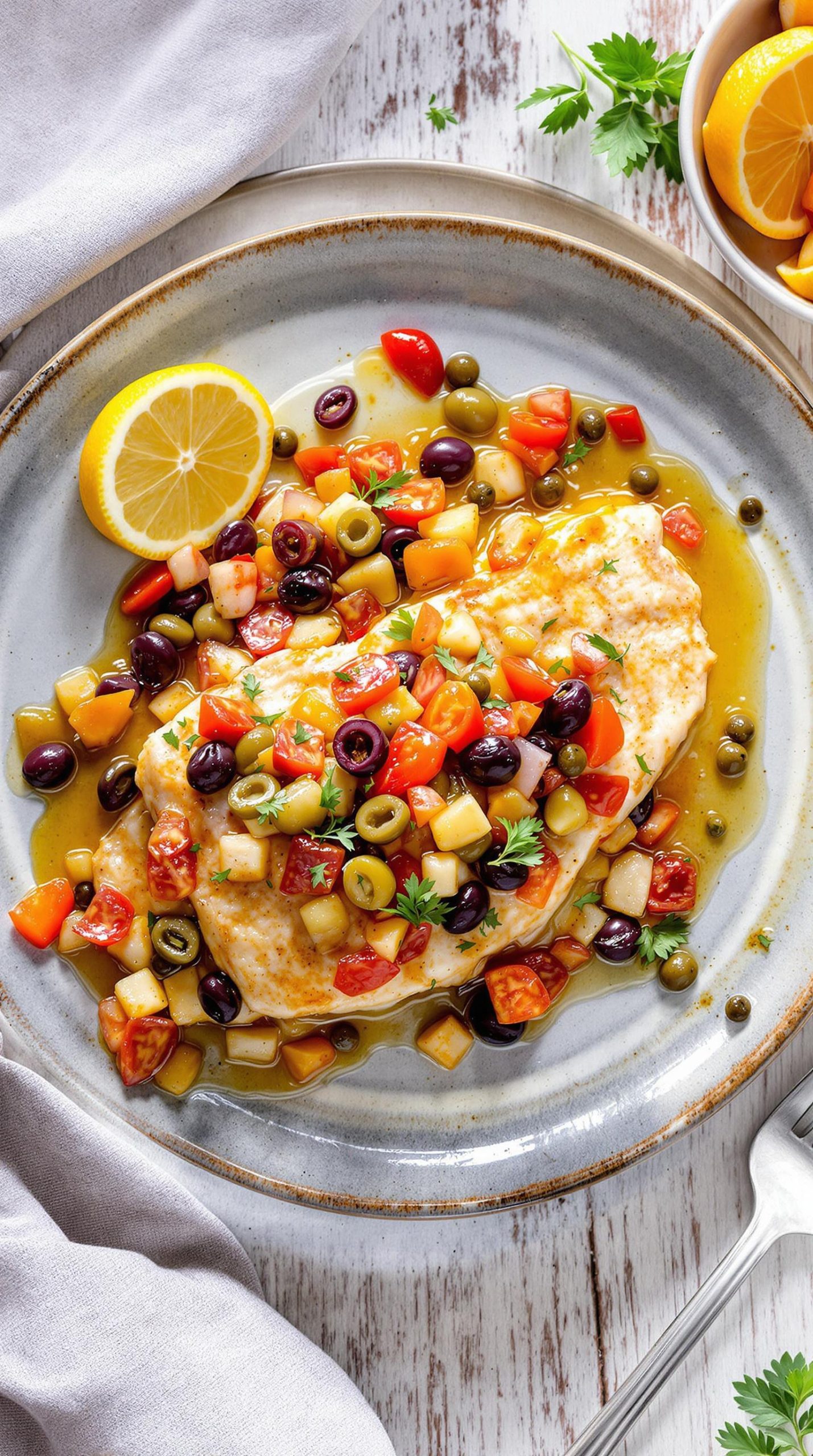Why You’ll Love this Mediterranean Baked Swordfish
If you’re craving a dish that brings all the vibrant flavors of the Mediterranean to your dinner table, this baked swordfish recipe is about to become your new favorite.
I’m talking about tender, flaky swordfish topped with a colorful medley of olives, tomatoes, and onions that create the perfect balance of savory, tangy, and sweet.
What makes this recipe truly special? It’s incredibly simple yet sophisticated. With just five ingredients and a half hour in the oven, you’ll have a restaurant-worthy meal that’s healthy, impressive, and absolutely delicious.
Can dinner get any easier than this?
What Ingredients are in Mediterranean Baked Swordfish?
This Mediterranean baked swordfish recipe truly embodies the “less is more” philosophy that makes Mediterranean cuisine so beloved. You don’t need a lengthy shopping list or complex ingredients to create something spectacular. The star of the show is obviously the meaty, mild-flavored swordfish, which provides the perfect canvas for the bright, zesty toppings that will infuse it with classic Mediterranean flavors during baking.
- 4 ounces swordfish steak
- 1/2 cup olives, chopped
- 1/2 cup tomatoes, chopped
- 1/2 cup onion, chopped
- 2 teaspoons olive oil
When shopping for these ingredients, quality matters more than quantity. Look for fresh swordfish that has a firm texture and doesn’t smell fishy—more of a clean, ocean scent. The type of olives you choose can really change the character of the dish; Kalamata olives add a more intense, briny flavor, while green olives offer a milder taste.
And don’t skimp on the olive oil—a good-quality extra virgin olive oil makes all the difference in a simple recipe like this one. Want to add a little extra Mediterranean flair? A sprinkle of fresh herbs like oregano or parsley wouldn’t hurt, though the recipe is perfectly delicious as is.
How to Make this Mediterranean Baked Swordfish

Making this Mediterranean baked swordfish couldn’t be simpler, which is honestly part of its charm. The entire process takes just minutes to prepare before your oven does the rest of the work. Start by preheating your oven to 350 degrees—a moderate temperature that allows the fish to cook through gently without drying out those precious juices.
While your oven heats up, prepare the Mediterranean topping by combining 1/2 cup chopped olives, 1/2 cup chopped tomatoes, and 1/2 cup chopped onion in a small bowl. This vibrant mixture provides all the moisture and flavor your swordfish needs.
Next, place your 4 oz swordfish steak on a baking sheet or in a small baking dish. Some folks like to line the dish with parchment paper or give it a light spray with cooking oil, though it’s not strictly necessary. Spoon the olive, tomato, and onion mixture directly on top of the swordfish, making sure to cover the entire surface. Drizzle 2 teaspoons of olive oil over everything—this helps the flavors meld together while adding a touch of richness. For an even easier preparation process, consider using a high end mixer stand to quickly combine your Mediterranean topping ingredients.
Pop the dish into your preheated oven and bake for approximately 30 minutes. The exact cooking time may vary slightly depending on the thickness of your swordfish steak. For perfect results, consider using a premium meat thermometer to ensure your swordfish reaches the ideal internal temperature. You’ll know it’s done when the fish flakes easily with a fork—a gentle prod should show the flesh separating into distinct layers rather than remaining firm and translucent.
The Mediterranean topping will have softened, releasing its flavors into the fish while creating a gorgeous, colorful presentation. Let the dish rest for just a minute or two before serving, which gives the juices a chance to redistribute throughout the fish for maximum tenderness.
Mediterranean Baked Swordfish Substitutions and Variations
While the classic Mediterranean baked swordfish recipe delivers incredible flavor, you’ve got plenty of options for making it your own through thoughtful substitutions and creative variations.
Can’t find swordfish? No problem. Mahi-mahi, halibut, or even tuna steaks work beautifully as alternatives.
For the topping, try capers instead of olives for a briny punch, or roasted red peppers for sweetness. Not an olive oil fan? Avocado oil offers a milder flavor profile.
Want to jazz things up? Add lemon zest, fresh herbs like dill or oregano, or a sprinkle of feta cheese before baking.
The Mediterranean flavors are forgiving, practically begging for your personal touch.
What to Serve with Mediterranean Baked Swordfish
Complementary side dishes elevate Mediterranean baked swordfish from a mere entrée to a complete culinary experience.
I love pairing this robust fish with a simple Greek salad—crisp cucumbers, ripe tomatoes, feta, and a lemon-oregano dressing. Divine.
Rice pilaf with toasted pine nuts makes an excellent base, soaking up those olive-tomato juices perfectly.
Or try roasted lemon potatoes, their crisp edges and tender centers balancing the meaty swordfish texture.
Need something green?
Sautéed spinach with garlic or steamed asparagus drizzled with olive oil works beautifully. Can’t you just taste it now?
Final Thoughts
As I look back on this Mediterranean baked swordfish recipe, I’m convinced it’s the perfect blend of simplicity and sophistication.
The combination of briny olives, sweet tomatoes, and aromatic onions creates a Mediterranean flavor profile that elevates the meaty swordfish without overwhelming it.
What’s not to love about a dish that comes together in minutes but tastes like you spent hours in the kitchen?
The olive oil gently infuses everything with richness as it bakes, creating a light sauce that’s perfect for spooning over the fish.
For a refreshing side dish, try a paper thin fennel salad dressed simply with lemon juice and olive oil to complement the robust flavors of the swordfish.
Isn’t that what great cooking is about—letting quality ingredients shine with minimal fuss?
For a different comfort food experience, try making a creamy soup recipe with tender potatoes and melted cheese for those cold winter evenings.





